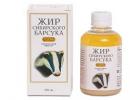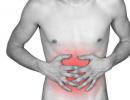How to raise hemoglobin in a child with folk remedies. How to increase hemoglobin in a child: useful tips
The baby was diagnosed with anemia, and parents begin to look for how to increase hemoglobin in a child. Correction of this indicator is necessary, because a decrease in hemoglobin level leads to a deterioration in the supply of tissues and organs with oxygen. The resulting condition is dangerous for the child's body and, without treatment, causes a developmental delay.
In contact with
Classmates
If the decrease in hemoglobin is not caused by diseases that disrupt the production of red blood cells, then you can raise it at home, following medical prescriptions.
 In children with a moderate decrease in hemoglobin, iron-containing foods can be tried to raise the hemoglobin protein in the blood. Your child's diet should include:
In children with a moderate decrease in hemoglobin, iron-containing foods can be tried to raise the hemoglobin protein in the blood. Your child's diet should include:
- turkey and rabbit meat;
- offal;
- beef;
- chicken yolks;
- seafood;
- legumes;
- buckwheat porridge;
- vegetables and fruits;
- nuts.
Dried apricot compote will also help to raise hemoglobin in the blood of a child.
The consumption of muffins, chocolate, condensed milk and sweet sodas should be limited, and it is better to completely exclude these products from the diet that reduce the level of hemoglobin protein.
Dairy products slow down the absorption of iron, but it is impossible to completely exclude milk from the child's diet - calcium is necessary for growth. During treatment, it is recommended not to mix dairy products with iron-containing foods.
With anemia, even in a mild form, since it is impossible to raise the hemoglobin level with food alone, the child is prescribed medications with iron. There are quite a few a large number of, dozens of titles. Preparations in syrups and solutions can be used for children, with virtually no age limit:
- Ferrum-lek;
- Ferlatum;
- Totem (from 3 months).
For children, an accurate dose calculation is required, which is based on the weight of the child.
Children's iron-containing preparations are well absorbed in the intestines, have a pleasant taste and help to quickly raise hemoglobin. Iron injections to raise hemoglobin are rarely prescribed. The indication for injections is a significant decrease in the level, which poses a threat to life.
What if there is a low level of Hb in the blood of an infant?
Starting to raise hemoglobin in a breastfed baby should be with a correction in the menu of a nursing mother. A woman needs to eat:
- beef;
- liver and other offal;
- vegetables;
- fruits and berries;
- legumes;
- seafood.
But, trying to raise hemoglobin in the baby, you can not eat a lot of recommended foods - this will cause indigestion in the child. new food it is necessary to add to the diet in small portions and monitor the baby's stool. If the baby feels well, then the next day you can add another healthy dish.

The diet of an older child must be healthy and balanced.
Adapted iron-containing mixtures will help to raise the baby, who is bottle-fed, hemoglobin. Health food selected by the pediatrician, taking into account the characteristics of the disease.
Anemia in pregnant women is often detected due to the fact that a growing child actively consumes iron, depleting the reserves of the mother's body. Women are interested in: how can hemoglobin be raised so as not to harm the fetus and improve their well-being. Doctors recommend:
- include food enriched with iron in the menu;
- take iron-containing drugs (with a strong decrease in hemoglobin index).
If anemia is detected, it should be treated immediately. A pathological decrease in hemoglobin causes fetal hypoxia and causes intrauterine growth retardation.
Useful video
Practical tips on how to increase hemoglobin in a child:
Conclusion
- Low hemoglobin in a child is a serious problem, as long-term preservation affects physical and mental development.
- Iron-rich nutrition without the use of iron-containing drugs is not able to increase hemoglobin in a child.
- Medicines are the same as for adults, but in a reduced dose. Children under 6 years of age can only be given syrups and solutions. Chewable tablets are also an acceptable option. All three forms of release have a pleasant smell and sweet taste, which is why they are well received by children.
In contact with
At the pediatrician's appointment after the donation general analysis blood often heard: "Your child has low hemoglobin." Mothers, especially those who experienced the phenomenon of low hemoglobin during pregnancy, are well aware that this is bad for the child, but not everyone knows the reasons that trigger the mechanism of this condition and, most importantly, what to do now, especially if the baby is on breastfeeding.
Hemoglobin and the norms of its content in the blood
Hemoglobin is a complex protein found in erythrocytes and containing bound iron, capable of reversibly retaining oxygen. Thanks to hemoglobin, the blood has a red color and gas exchange occurs in the body: the transfer of oxygen to the cells and the intake of carbon dioxide from them.
Therefore, with a low content of this complex protein, oxygen will not enter the body in sufficient quantities and the cells will begin to suffocate.
Norms of hemoglobin in the blood depending on the age of the child
As you can see, the highest levels of hemoglobin content are observed in children immediately after birth. It should be noted that hemoglobin itself in newborns is not the same as in adults, as it has an increased ability to bind and carry oxygen. However, it is less resistant to temperature and acidity of the environment. The hemoglobin of the fetus and newborns is called fetal hemoglobin. Over time, this type of hemoglobin changes to adult hemoglobin.
Important! A decrease in hemoglobin occurs most often simultaneously with a decrease in the number of red blood cells in the blood. In medicine, this condition of the body is called anemia, which is not a specific disease, but may be a sign of it or indicate a different pathological condition of the body.
However, the most common is anemia due to iron deficiency or iron deficiency anemia. Actually about it and will be discussed further.
Dr. Komarovsky talks about low hemoglobin in children
Causes of Low Hemoglobin Related to Iron Deficiency (Iron Deficiency Anemia)
In the neonatal period, the level of hemoglobin is closely related to the characteristics of the course of pregnancy and childbirth. Here are some of them.
- mother's anemia during pregnancy;
- premature birth;
- early aging of the placenta;
- premature or multiple pregnancy;
- too early clamping of the umbilical cord.
In the future, the reasons for the low content of hemoglobin in a healthy infant at birth, as a rule, are due to the usefulness of his nutrition, as well as the nutrition of the mother of the baby who is breastfed. Nutritional value here, first of all, is understood as sufficient intake of iron, the lack of which leads to iron deficiency anemia.
Iron deficiency anemia of the newborn
Symptoms
- skin, mucous membranes of the conjunctiva of the eyes are pale;
- general lethargy, capriciousness, slight excitability;
- sweating;
- there is no appetite or it is reduced;
- sleep disturbance;
- the child does not tolerate physical activity;
- dry skin;
- painful cracks in the corners of the mouth;
- fragility and hair loss;
- dullness and brittle nails.
The diagnosis of iron deficiency anemia is finally confirmed by laboratory tests, which take into account such indicators as hemoglobin content, average hemoglobin concentration in an erythrocyte, average erythrocyte volume, iron content in blood serum, iron-binding ability of blood serum, etc.
Prevention and treatment
Important! Proper nutrition of mother and child is the main condition for maintaining a normal level of hemoglobin in the blood.
All of the above measures will not help if iron deficiency in the body is high and has been observed for a long time. In this case, the pediatrician prescribes iron-containing preparations, which are taken based on the weight of the child. Optimal daily dose iron is 2-4 mg/kg. Higher doses of iron are not absorbed by the body.
In children early age iron deficiency anemia leads to impaired absorption of vitamins and other trace elements, therefore, in addition to iron-containing drugs, vitamins are prescribed.
The first improvements in iron deficiency anemia are observed after 10-12 days of treatment prescribed by a pediatrician. However, treatment should continue after normalization of the hemoglobin level in the blood in order to ensure an adequate supply of iron. Another cause of low hemoglobin should be suspected if there is no improvement after four weeks of treatment.
As a prophylaxis, iron preparations are prescribed
- premature babies (from 2 months);
- children from multiple pregnancy;
- children from pregnancy and childbirth with complications;
- large children with a high increase in weight and height;
- children with chronic and allergic diseases;
- children after surgery.
Low hemoglobin is the main cause of anemia, dizziness and fatigue in children. How to raise hemoglobin in a child with medication and folk remedies, all mothers should know, but this must be done under the supervision of a pediatrician. He will determine the causes that led to iron deficiency, and prescribe adequate treatment.
The following factors lead to a low level of hemoglobin:
- A lack of protein in a child occurs when an insufficient amount of iron enters the body. Approximately 5% of this trace element is excreted every day naturally. Its reserves are replenished by good nutrition.
- Iron is heavily lost during bleeding. In adolescent girls, the concentration of hemoglobin drops during menstruation.
- A nursing baby does not experience a lack of iron-containing protein if it feeds on mother's milk. Artificial feeding, for which cow's milk is taken, sometimes leads to a lack of iron. In this product, it is in a bound state, it is impossible to isolate it.
- Anemia occurs with enteritis, gastritis, peptic ulcer, in which absorption nutrients through mucous membranes digestive tract decreases. Because of this, an insufficient amount of iron enters the blood.
- TO low level hemoglobin leads to a deficiency of vitamin B 12 - a compound that transports iron into the bloodstream.
- When a pregnant woman eats poorly or irrationally, suffers a cold, little iron accumulates in the baby's liver. In this case, the newborn suffers from a hemoglobin deficiency immediately after birth.
- Hemoglobin drops if children are poisoned by toxic substances that can destroy red blood cells.
Permissible norms
Hemoglobin concentration in childhood fluctuates:
- in a newborn in the first three days, it reaches 180-240 g / l;
- in infants up to a month - 115-175 g / l;
- in a baby 2–12 months old - 110–135 g / l;
- from one year to 12 years of age - 110-145 g / l;
- in adolescents - 120-155 g / l.
When a baby has low hemoglobin, its level is quickly raised with iron-containing medicines. There are medicines for children as young as 1 year old. However, on early stages development of anemia, pediatricians insist on correcting the nutrition of the baby and mother. They are advised to eat foods rich in iron.
Symptoms
When anemia occurs in a child:
- poor appetite;
- fatigue, weakness;
- drowsiness;
- decreased activity;
- apathy;
- dizziness;
- cracks in the corners of the lips.
The child's nails break, the hair loses its luster, fades, falls out, the skin turns pale, acquires a yellowish tint. The epithelium is dry, scaly. Dark circles under the eyes, heart rate is fast. Immunity is lowered, the baby is constantly sick. Diseases are difficult, give complications. If iron deficiency is not eliminated, children are noted to lag behind in physical and mental development.
Drug therapy
Children usually have iron deficiency anemia. If the hemoglobin level is low, both the one-year-old baby and the older child need urgent therapy. The pediatrician determines the cause of anemia and prescribes treatment.
With iron deficiency anemia, it is necessary to adjust the diet and give medications prescribed by the doctor. Medicines are prescribed for three months. An increase in hemoglobin occurs if the child takes:
- prolonged medicines: Ferograd, Ferrum-lek, Irovit;
- short-term agents: ferrous fumarate, ferrous sulfate.
If an infant or child is sick younger age, the doctor prescribes drops or syrup. Terrible children are given chewable lozenges; active substances from them are gradually absorbed into the blood from the intestines. 
Positive dynamics should occur after 30 days of treatment. It is determined by blood tests. The lack of a therapeutic effect is due to:
- wrong dose;
- misdiagnosis (non-iron deficiency anemia);
- irregular intake of medicines.
diet therapy
Nursing mother and baby need to follow a special diet. Beef is the main product that compensates for iron deficiency. The meat is boiled or steamed. The menu includes offal: kidneys, liver, as well as the meat of other animals.
There is not much iron in fish. The body will be saturated with a microelement faster if seafood dishes (caviar, shrimp) are added to the diet. 
Vegetable food from legumes and buckwheat helps to increase hemoglobin. It is useful to eat beans, peas, lentils, as well as rye and wheat bread.
Eliminate the lack of iron-containing protein vegetables, berries, fruits. Hemoglobin increases if children eat beets, potatoes, tomatoes, gooseberries, apples, carrots, zucchini, pomegranates, quince, rose hips, pears, strawberries, watermelons, raspberries, persimmons, currants.
In order for foods that increase hemoglobin in children to benefit, it is necessary to remove foods containing calcium from the diet. This trace element hinders the absorption of iron. During the diet, dairy products are given to children in limited quantities ( breast milk cannot be ruled out). Milk, cottage cheese, sour cream, yogurt, kefir are temporarily removed from the diet.
To raise the concentration of iron-containing protein, restrictions on caffeinated drinks are introduced. Instead of tea, Coca-Cola, cocoa, kissels, compotes, fruit drinks are prepared, herbal decoctions, juices.
Alternative treatment
If the mother monitors the health of the child, controls his nutrition, uses folk remedies that maintain the concentration of hemoglobin within acceptable limits, he does not develop anemia. It is real to raise hemoglobin in a child without medication. Enough to take advantage folk recipes that have stood the test of time.
Simple remedies help to increase the concentration of iron. Many of them are enjoyed by children. They increase hemoglobin to an infant, who has reached 7 months, and older children.
This or that home preparation is forbidden to use if it gives an allergic reaction or other by-effect. In the event of undesirable manifestations (rash, itching, etc.), the remedy is canceled.
It is possible to increase the concentration of iron-containing protein using:

It is strictly forbidden to treat anemia in a child without consulting a doctor. Self-medication leads to the development of complications. Without tests, it is impossible to track the level of hemoglobin. Folk remedies and medicines will not help if the baby does not suffer from iron deficiency, but from another type of anemia. Only a doctor can understand the causes of low hemoglobin.
At the beginning of the life of the crumbs, most young parents are faced with such a disease as low hemoglobin in an infant. This phenomenon is quite common not only among young children, but also among adults. The initial signs of low hemoglobin may already appear. This blood disease is well studied, quite understandable from a medical point of view, the physiology of the child, the causes of its occurrence, symptoms and methods of treatment have been sufficiently studied.
General information about hemoglobin
Low hemoglobin(in medicine - anemia, iron deficiency anemia) is a low content of red blood cells in the blood. The main task of red cells is the transfer and return of oxygen molecules to organs and tissues to obtain energy and ensure the vital activity of the body. A low hemoglobin level will negatively affect the overall development and physical condition baby-baby.
In babies up to a year old, the hemoglobin indicator in the blood should not be below 105 g/l. In children in the second year of life, anemia is indicated by an indicator less than 100 g/l.
Causes of loss of hemoglobin in the body
There are a lot of reasons for the decrease in red blood cells in the blood of an infant. This could be factors:
- External (operations, unbalanced nutrition, anemia of a pregnant mother);
- Internal (hereditary pathology, immune, infectious diseases);
- Features of intrauterine development.
Prenatal period of development and the formation of the child's body absolutely dependent on the health of the mother, organizing it proper nutrition, presence/absence bad habits, hereditary diseases, etc. The stock of iron accumulated by a newborn during fetal development will be enough for about the first six months. After this time, there is a decrease in hemoglobin. Further normal level hemoglobin can be maintained through continued breastfeeding and.
When artificially feeding an infant, the level of red blood cells should be maintained using a special enriched baby food with the addition of complementary foods (meat, fish, fruits, vegetables, vitamins) in subsequent months, which can correct the level of hemoglobin.
It is necessary to take into account the intensive development and growth of the child in the first year of life, when significant changes occur in height and body weight. Accordingly, consumption in energy production increases, and hence in the production of red blood cells, which the body may not be able to cope with for various reasons.
Conditions for the normal formation of hemoglobin
- Breastfeeding should continue for as long as possible.
- The diet of a nursing mother and an infant who is on artificial feeding should be balanced.
- Normal functioning of the gastrointestinal tract, blood formation systems.
- Absence of acquired or hereditary blood diseases.
- The presence of animal protein in food.
Symptoms of iron deficiency anemia
Symptoms of low hemoglobin in an infant can be divided into primary and secondary.
Unfortunately, for such primary signs as: loss of appetite, constant weakness, increased fatigue, general unsatisfactory condition of the child, parents do not always pay attention.
The progression of the disease in the future can be expressed in the following external signs:
- pale skin (up to an icteric shade);
- causeless increase in temperature to 37.5º;
- dark circles under the eyes;
- drowsiness;
- dizziness;
- cardiopalmus;
- dry skin.
Prevention and treatment of iron deficiency anemia
It is necessary to treat anemia in infants, as it will lead to oxygen starvation of the whole organism, will inhibit work nervous system, will create the prerequisites for a lag in general and mental development, worsen general state baby. iron deficiency anemia can be easily prevented by balancing the child's diet.
When breastfeeding, the baby's need for iron will be fully satisfied up to almost 6 months due to the good absorption of iron in milk (up to 50%), which is much higher than in other products. By the end of the first year of life, the child's diet is significantly expanded, so it is possible to adjust the amount of iron entering the body.
The high content of iron contains buckwheat, apples, beets, meat, liver, apple and pomegranate juice And.
However, pomegranate juice must be diluted with water (1:1) to avoid problems with the gastrointestinal tract.
Thus, in order to increase the level of hemoglobin in baby need to eat:
- Lots of fruits: blueberries, apricots, dried apricots, apples, strawberries, pomegranates;
- A lot of meat: beef, turkey, liver, veal;
- Any products made from wheat flour;
Treatment medicines anemia (low hemoglobin) must be prescribed by a pediatrician.
It worries many parents. For a complete answer, it is important to know and understand that it is better to identify problems in the early stages of its development, then ordinary ones in children can help. You will also need to know the rate of this substance in the children's body.
It is important! So, for newborns at the age of one month, the normal concentration of hemoglobin should be considered 107 - 117 g per liter of blood. This level can change up to 140 g per liter of blood. Already from one year to five years, the hemoglobin level is 115-145 g per liter of blood, and by the age of 11-12 it is set at around 125-150 g per liter of blood.
In this regard, before increasing hemoglobin, you will need to get accurate results blood tests that will inform about the deviation from the norm, and classify the causes of increased. If the test results indicate a decrease in hemoglobin, then you need to consult a doctor and take appropriate measures.
Manifestations and consequences of a decrease in hemoglobin
When ignoring deviations of hemoglobin values from the norm, children may show severe weakness, frequent lesions viral diseases, deterioration of the immune system - the child begins to get sick much more often than peers, also notes rapid fatigue after mental exercise or after physical exercise.
In children, the symptoms of this disorder are quite pronounced. TO outward signs include the following:
- Blue lips.
- Paleness of the skin and mucous surfaces.
- Severe peeling of the skin.
- Brittleness of hair and nails.
- Stomatitis.
- Shortness of breath even when walking.
- Frequent colds.
Measures to restore the norm of hemoglobin
If a woman faces the problem of reducing the concentration of this protein during lactation, then the child should receive all the substances necessary for the child's body with milk. It turns out that you should focus on the nutrition of the mother - it should be balanced, with a high concentration of iron in the products. Your daily meal should include following products: organ meats, red meat, liver, kidneys, tongue, cereals, apricots, pomegranates, prunes, blueberries, and all red and black berries.
In older children, with a decrease in hemoglobin, it is first necessary to pay attention to nutrition. The diet must include cereals, fish, meat and vegetables. If the child does not like meat very much, then it is necessary to give him a lot of cereals, berries and fruits.
An increase in hemoglobin in children begins with the use of ordinary buckwheat porridge with the addition of green onions. In addition, children over the age of two are allowed to give pomegranate berries, as it contains a large amount of iron necessary for the body. It is better to refuse to include dairy products in the diet, because calcium interferes with the absorption of iron and only harms in this situation. If the child is very fond of milk and yogurt, it is important to separate the consumption of foods containing iron and foods containing calcium.
It is important! In addition to the described techniques for restoring hemoglobin, one should not forget that with a decrease in its concentration, the supply of oxygen to the whole organism worsens. In this regard, it is important to add regular walks in the fresh air, away from roads and crowds of people, to the appropriate catering. The best place for a walk - this is a forest or a park where the child will be able to relax and get a charge of vivacity.
Increasing hemoglobin in children with the help of products
 Products that help restore hemoglobin when it decreases include:
Products that help restore hemoglobin when it decreases include:
- Meat: heart, kidney, poultry, tongue, white chicken meat and fish meat. To maintain the norm of hemoglobin in the body, 50 g of boiled beef tongue should be consumed every day.
- Cereals and cereals from them - rye, buckwheat, lentils, beans, oatmeal and peas.
- Greens and vegetables: potatoes - better young baked with peel, tomatoes, onion, beets, pumpkin, green vegetables, young turnip tops, dandelion leaves, parsley, spinach.
- Fruits: green and red apples, bananas, plums, pears, pomegranates, apricots and peaches, quinces, persimmons.
- Berries - red and black currants - frozen produce the same effect, cranberries in sugar, strawberries and strawberries, blueberries.
- Juices - pomegranate - at least two sips every day, carrot and beetroot, red apple juice with a high concentration of iron.
- Other products such as black and red caviar, walnuts, egg yolks, dark chocolate, dried fruits, dried mushrooms and hematogen.
The human body, including the child, is designed in such a way that, despite the amount of iron intake, it will process only a certain amount of this substance, so we increase the hemoglobin of children with caution, the main thing is not to overdo it and not harm the body. It is important to remember that only drugs can quickly restore the concentration of hemoglobin, for the appointment of which it is necessary to consult a doctor.






